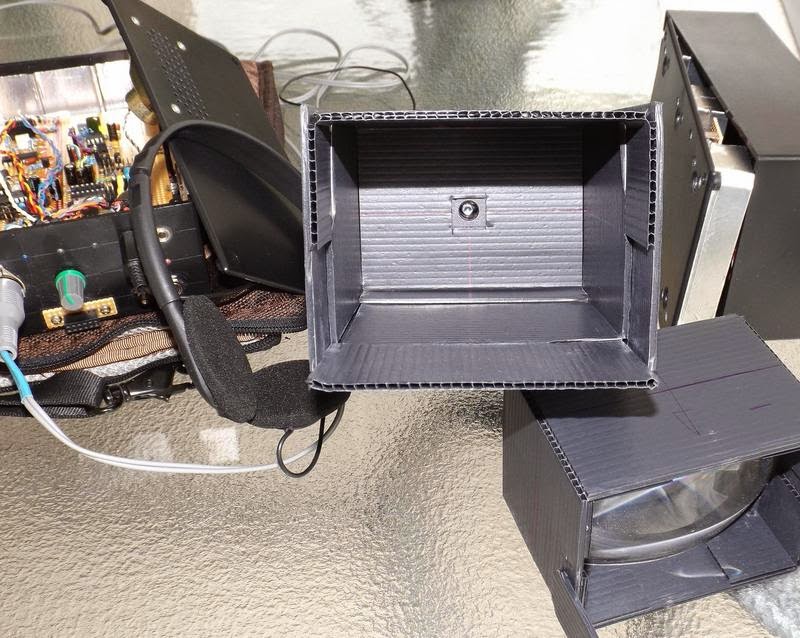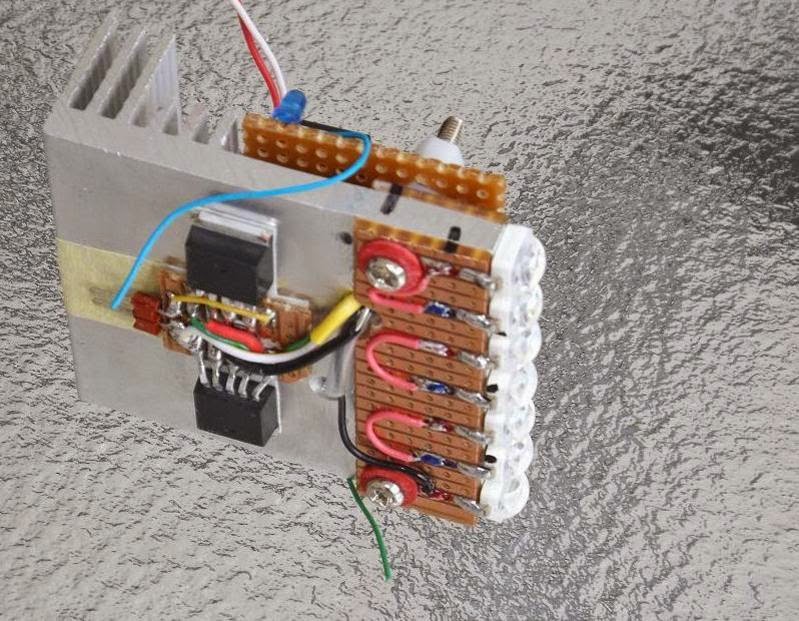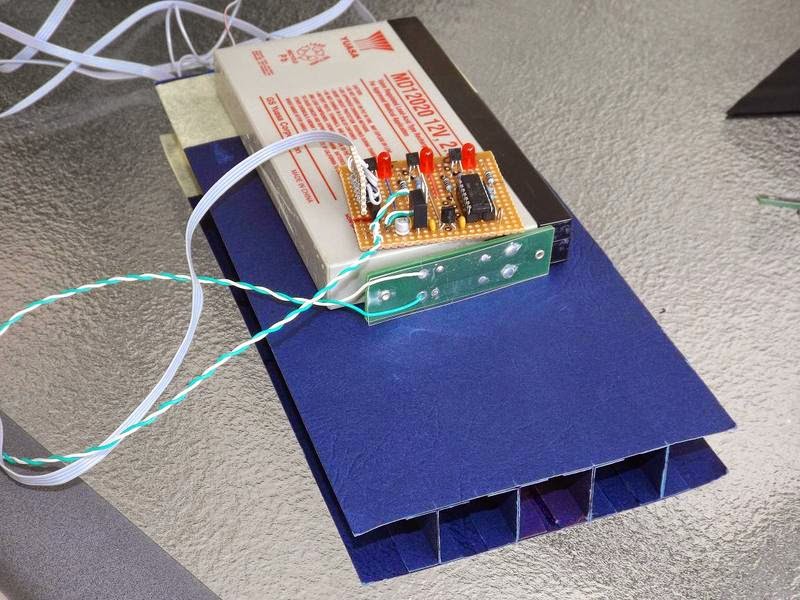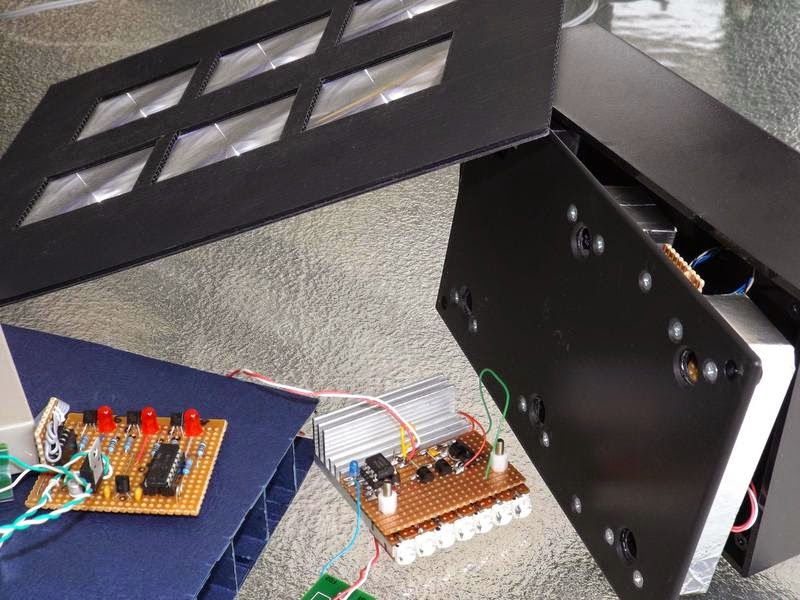Archive for the ‘Uncategorized’ Category
 VK4EBP’s NLOS Lightwave Experiments – Part 3
VK4EBP’s NLOS Lightwave Experiments – Part 3
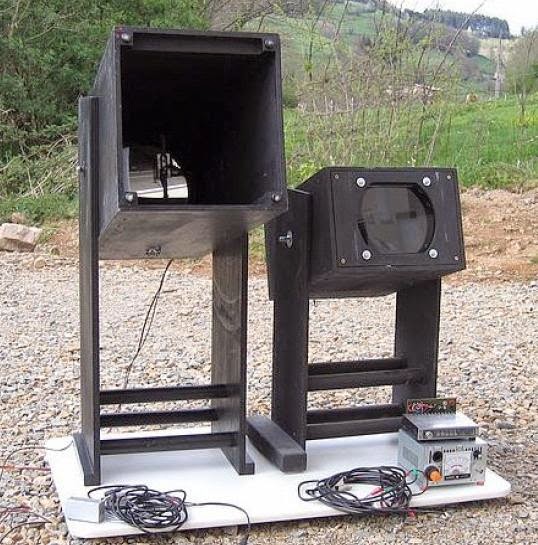 |
| F1AVY's Cloudbounce System |
"Returning to Steve's questions and our general discourse:
..is it (the RX) fairly small and portable...and lensless?
I do have a lens in the RX I now prefer to use - although it happens to be a convex lens from a tabletop magnifier - about 7x12cm giving me a narrow reception beam and a fair bit of gain compared with naked photodiode. There seems to be a general agreement that increasing the size of receiving aperture will capture more light and is the best way to greater gain.
Here I need to qualify gain requirements for my particular applications. I am currently exploring relatively short-distance NLOS paths in urban environments with abundant QRM from city and suburban lights, and this already limits my gain requirements. I developed my own qualitative test of satisfactory sensitivity - by pointing my receiver at individual stars in the sky. If I can hear them twinkle (yes they do twinkle!!!) then I am generally satisfied with the project.
On cloudy nights, pointing the RX into the clouds brings an interesting combination of mains harmonics and general hash from neon lights, clicking pulses from aeroplane lights, sweeping sounds from airport and marine lighthouses. In an environment like this, going to extreme lengths as one would do for very long-range cloudbounce or LOS comms in dark and secluded areas is simply not required and uneconomical. I initially did invest time and money in large receiving boxes with the best components there are, only to find that, unless I moved out into the bush, I could not take a real advantage of the improved performance, and did equally well with smaller and more wieldy portable designs.
"Is the idea, when talking about NLOS, to light up as much sky as possible...and that is why no focusing lenses are employed? Would a focused emitter, as produced by the typical Fresnel lens light box, produce too narrow a beam than desired? It would seem likely that with precise aiming combined with the gain to be had by utilizing fresnels (for example), would produce longer paths??"
There are several separate issues there. One is the implied requirement for a large Fresnel lens in order to obtain a narrow beam. First, how narrow is narrow enough? If we can be satisfied with say +- 5 degrees then there are more wieldy solutions available - most of the high power LEDs now have clip-on small spot lenses awailable separately - usually from third-party manufacturers. These were unheard of until recently. Standard-sized LEDs are available with very narrow radiation pattern, e.g. the SFH4550 at barely +-3 degrees. And one would expect an array of 200+ of them to behave quite like our stacked Yagis, many times over! Hence narrow beam is quite possible even without an external lens.
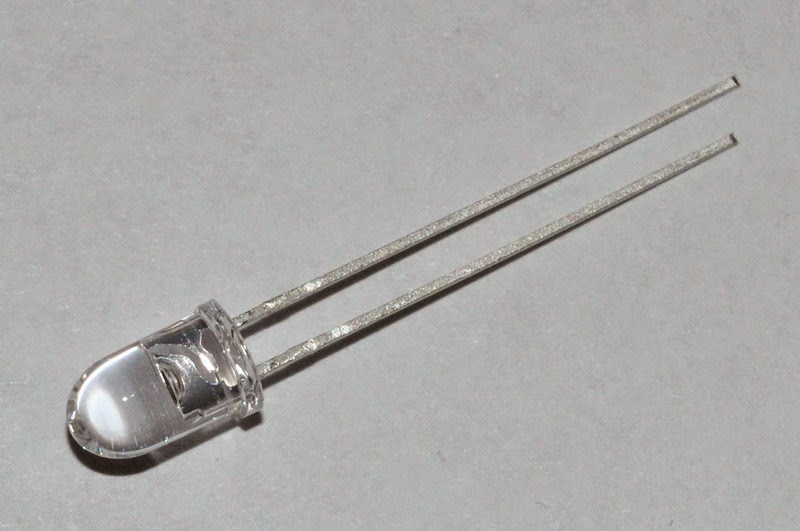 |
| Osram SFH4550 IR LED |
Of course the extremely narrow beams that one would prefer for LOS DX comms would be next to impossible to align in NLOS situation. (Invisible infrared is not a problem in LOS as it can be easily supplemented with e.g. a plain strobe light for alignment purposes.) I find my +-3 degrees array (with similar +-3 deg aperture at receiving end) hard enough to align over the horizon, and it is probably the limit of how narrow one can go to remain practicable in NLOS.
"to light up as much sky as possible..."
It is possible that cloudbounce and obstruction-bounce will develop into separate NLOS techniques, along with atmospheric scatter. Of course one can think of all of these in some topographies.
I had some success in inter-suburban cloudbounce with high beam elevations at both ends - 30 to 60 degrees. Also with 45 degrees or less elevation with TX and RX about 1km apart side by side and pointing at the same cloud in the distance. Power used around 10-20W, beamwidth +-5 to 10 degrees, red and infrared with similar results (including 950nm). The received signal was just strong enough for telegraphy or qrss, but never near enough for any type of voice modulation. Results were affected by the height of cloud cover necessitating frequent elevation adjustment, and an additional liaison channel on VHF. Signals disappeared entirely as soon as the clouds started producing rain.
I never got any usable results with clear night sky and the TX and (imaginary) RX beams crossing each other at similar elevations. Only at very close distances - the best signals being received with blue and infrared. Presumably Rayleigh scatter with blue. (This raises the possibility of usable atmospheric scatter with UV?)
Only recently I commenced preliminary tests with close-to-ground, low-elevation NLOS and immediately the infrared proved itself to be a clear winner with quite reliable and repetitive results. (Needless to say the signal strengths are marginal compared with direct LOS over similar distance.) Intuitively, one would suspect general scatter and bouncing of nearby objects being the main sources of some of the energy reaching over the horizon, with some contribution perhaps of atmospheric/dust/aerosol scatter.
This adds an additional dimension to your question.. to light up as many objects around the TX(or around RX, or around the obstruction) as possible, or send the focused beam as far as possible? I guess it will very much depend on topography. I can imagine a situation where I would prefer to use a broad floodlight rather than a focused beam - e.g. to illuminate as many as possible of the surrounding tall buildings if transmitting from a ground floor apartment. Or from the foot of a mountain. An opposite rule would apply if it is the receiver that is just behind an obstruction - here a focused TX beam and a broad RX aperture might prove advantageous. And where the main obstruction is midway between TX and TX than the usual narrow-beam configuration would apply at both ends. I think it might be worth trying an infrared TX with interchangeable lenses, and same for the RX...
The portable TRX image shows the general view. Most of the electronics is contained in a plastic box and includes an SLA battery, the RX audio bandpass filter, power amp and speaker, and most of the PWM AM TX circuitry except the final LED driver. The DIN socket provides connection to external RX front end TX output drivers and LEDs, usually held together on a tripod. The header socket is for the external microphone connection, and there are switches for power and speaker and a headphone jack. The crudely made corflute box beside it is the RX front end with lens, photodiode and preamp.

The RX detail 01 shows the business end of the photodiode, and the separate lens box (slides in and out for focus adjustment). Detail 02 shows the preamp with interchangeable photodiode modules - SFH213 for visible to 850nm, and the SFH213-FA for 850nm and below.
Multi-wavelength TX 01 (front and back image) includes several groups of fat LEDs (red, blue and 850nm) with matching lenses providing approx. +-5 degrees apertures. Also the PWM driver on 2x CAT4101 in parallel, external high current power connection, intensity control, and a PICAXE-controlled strobe or audio callsign/frequency sweep beacon.The whole assembly connects to the TRX control box (above) and can provide power to it, draw power from it, or have both DC sources in parallel.Enclosure includes a photo tripod mount on the bottom plate, and velcro strips on top to hold the RX front end.
Pocket-sized 10W IR TX is a small holiday project and still work in progress. The 7x LEDs are 2W each SFH4783 with an intrinsically narrow beam of +-10 degrees - quite appreciable for a naked LED of this size and possibly obviating the need for external optics in some applications. My usual CAT4101 drivers are included and capable of providing 2A at 50% duty cycle. Another Picaxe beacon is on the other side of the heatsink, and the voice modulator is still in progress.
The low-power multi-wavelength TX is another one day project, built to compare relative performances of 850 and 950nm IR. Three almost identical beams of red, 850 and 950 are transmitted in sequence with approx 100mA PWM running each diode. Unique CW ID has been coded for each wavelength.
6x SFH213 photodiode with individual preamps - quite a respectable low noise, high sensitivity front-end that works very well without external optics (SFH213 have a +-10 deg intrinsic apertures). A matching array of small fresnel lenses has been built and tested for narrow-beam reception, but a permanent box is yet to be added.. Some of the other gadgets seen in the foreground."
As mentioned earlier, Jan's experiments with NLOS signals utilizing IR is of particular interest to myself as I would like to continue experiments with VE7CA, on the other side of Georgia Strait...hopefully with Markus not having to move to a LOS position, but simply aiming across the Strait in a direct path, from his yard. Using Argo and QRSS3 mode, it will be interesting to see if any signals can be recovered from the cloud bottoms on some overnight runs.
More information on NLOS work may be found on the Australian Optical DX Group in Yahoo Groups as well as in the UK Nanowave Group....why is it that these two countries have so much homebrew fun??,,,and don't forget Clint's (KA7OEI) superb Optical Communications / Moduulated Light pages!
 The Spectrum Monitor — January, 2015
The Spectrum Monitor — January, 2015
Stories you’ll find in our January, 2015 edition:
K3LR: Contesting With the Big Guns
By Mark Haverstock K8MSH
Looking at the cover photo on this month’s TSM prompts the question, “Does this guy have enough antennas?” That’s a question that’s been asked hundreds of times by drivers on Interstate 80 who pass by the amateur radio antenna farm just east of the Ohio border. Tim Duffy K3LR says, “No. You can never have too many antennas!” Since 1987, Duffy has spent countless hours building his dream station, as well as collecting numerous contest awards along with the operators that make up the K3LR Contest Team. This is their story.
Monitoring Utility and Amateur Radio Transmissions with a DVB-T Dongle
By Mario Filippi N2HUN
With a small investment, any radio hobbyist can expand the reception capabilities of a DVB-T dongle to include long wave, medium wave and short wave frequencies. Creative individuals in the software industry have realized the potential of these diminutive, economically priced devices and have crafted programs that allow the dongle to function as multi-mode Software Defined Radios, when attached to a USB port of a computer.
Volunteer Interceptors: Listening for Terrorists
By Bob Patterson K5DZE
Any amateur, SWL or scanner monitor, who listens to a range of frequencies on a regular basis, soon learns what normally is heard over that range. These frequencies become the operator’s “radio
neighborhood.” Should a Volunteer Interceptor (VI) service be organized within the radio enthusiast community to monitor radio frequencies for possible national and international threats?
AMIKO A3 FTA Satellite Receiver
By Ken Reitz KS4ZR
If Apple made a Free-to-Air (FTA) satellite receiver it might look and perform like the AMIKO A3. In fact, opening the A3’s box, you might think you were opening a Mac; electronics manufacturers all seem to have taken a tip from Apple’s packaging concept. The Mac reference is a plus and a minus. Like a Mac, the A3 is modern in design, ruggedly built, and takes a little getting used to.
Why Go Digital?
By Cory GB Sickles W3UUV
Digital voice (and data) radios are certainly here to stay. This is one of the fastest growing and evolving aspects of amateur radio today. Although DV’s roots extend back more than 25 years, we’re still introducing new ways to communicate with ones and zeros, through methods that will eventually put analog VHF FM where HF AM is today.
Scanning America
By Dan Veenaman
Monitoring Digital Systems
Federal Wavelengths
By Chris Parris
A Year in Federal Monitoring
Utility Planet
By Hugh Stegman NV6H
More Russian “Numbers” Mysteries
Digital HF: Intercept and Analyze
By Mike Chace-Ortiz AB1TZ/G6DHU
Have PacTOR, Will Travel The High Seas!
HF Utility Logs
By Mike Chace-Ortiz and Hugh Stegman
Amateur Radio Insights
By Kirk Kleinschmidt NT0Z
Current Balun Bonus: Noise Reduction?
Radio 101
By Ken Reitz KS4ZR
The View Ahead, Through the Rearview Mirror
Radio Propagation
By Tomas Hood NW7US
Fundamentals: Radio Wave Propagation
The World of Shortwave Listening
By Jeff White, General Manager, WRMI Shortwave
Shortwave Listeners make their Voices Heard
The Shortwave Listener
By Fred Waterer
Change and Opportunity in the New Year
Maritime Monitoring
By Ron Walsh VE3GO
Marine Radio Traffic and Heritage
The Longwave Zone
By Kevin O’Hern Carey WB2QMY
Firing Up the Neophyte 1
(Formerly: A Cure for PPHD)
Adventures in Radio Restoration
By Rich Post KB8TAD
Back to the Future
The Broadcast Tower
By Doug Smith W9WI
This is a Test. This is only a Test.
Antenna Connections
By Dan Farber AC0LW
On The Road Again: Mobile Antenna Concepts
The Spectrum Monitor is available in PDF format which can be read on any desktop, laptop, iPad®, Kindle® Fire, or other device capable of opening a PDF file. Annual subscription (12 issues, beginning with the January 2015 issue) is $24. Individual monthly issues are available for $3 each.
 QRP SSB kits from Spain
QRP SSB kits from Spain
EA3GCY sells a range of QRP kits including single band, single PCB, SSB transceivers for 20m or 40m. These look easy to build and test and good value for money. Currently there is a 5% off offer running too.
See http://ea3gcy.blogspot.it/2013/03/iler-20-4-5w-qrp-ssb-monoband.html .
See http://ea3gcy.blogspot.it/2013/01/iler-40-4-5w-qrp-ssb-monoband.html .
He also does a CW kit and other accessories. Look out for the ILER range.
 Falling sunspot numbers?
Falling sunspot numbers?
Sunspot number for Dec 27th 2014 has fallen to 92 and 10m propagation is forecast to be “fair”. Although we’ll still get good days, we must now expect sunspot numbers to gradually decline as the years go by towards the next sunspot minimum. Usually the decline downwards tends to be faster than the climb after the minimum, although many are predicting that the next maximum (cycle 25) will be miserably low.
See http://www.solen.info/solar/ .
See also http://sc25.com/ .
 D-117
D-117
A warm Christmas wish to everyone celebrating this holiday. Over here in Taiwan it is business as usual since December 25 was axed as a day off many years ago. Nevertheless, we do have some Christmas cheer and we will save up the rest for Chinese New Year next February.
Like many of you, I also haven’t had much radio time lately. Life is busy with my three full time jobs (father, housekeeper and teacher) and both the sun and local noise haven’t given me much pleasure when turning on the radio. But I did get a new toy and have been playing with it for the last two weeks. My always lovely wife was so nice to purchase some telegraph keys in China on her last trip there. The one I’m playing with now is this beauty….

a NOS D-117 straight key from the Tianjin City Xinxing Communication Devices Factory. All shiny and very heavy: almost a kilogram. Unfortunately the box had been taped over, but after carefully peeling away the paper the stamped on date of packing was just visible and it read 1973. So I got a real piece of history in my hands as it was made during the cultural revolution. Even after 41 years the spring was still as stiff as a board. After keying with it for only a few minutes I could already feel my wrist getting sore. 24 hours of compressing the spring helped a bit, although my elmer and QSL manager PG2W would still find the tension too high. As faith would have it, my first on-air QSO with this key was with BG3FB who happens to live in Tianjin City, the place where the key was made 41 years ago.
So how do I like this key? It’s a joy to operate. Solid as a rock and if I bring the spring tension further down (and reduce my heavy pounding a bit) even the last bit of sliding will be gone. In overall performance I rate it just below the Junker key; you can’t beat German excellence. A keeper and if you can get your hands on one I recommend it heartilly.
A couple more days till Straight Key Night and the SKCC January Celebration. So get those straight keys and bugs out and start practising. 73!
 Second batch Xiego X-108 Radio debut, well almost
Second batch Xiego X-108 Radio debut, well almost
X108 HF Radio Second run
Those who have already received the updated radio say it is like night and day between the first batch and the second. Audio on SSB is much cleaner and clearer and the over-driving of the front end has been fixed. AM is also much better sounding according to those using the radio.
The firmware has been changed as well so the microphone buttons can be programmed by the end user to their choice and option for buttons on the microphone, as well a cw side-tone volume control has been added into the menu options.
So see what the mailman brings on Wednesday, if nothing I will update my blog once the radio arrives and load some videos to my YouTube Channel of its performance.
Merry Christmas and Happy New Year one and all.
Fred
VE3FAL
 Sending APRS messages to Twitter via the International Space Station
Sending APRS messages to Twitter via the International Space Station
HamRadioTweets is a service that was originally developed and operated by Bruce Sutherland KO4IN. The idea behind his work was inspired by conflicts overseas, it was meant to be a proof of concept on how to get your message out if your government restricts your internet access.
Mr. Sutherland originally created the software as a means to send messages over satellite such as the International Space Station and others that have on-board APRS Digipeaters. I am however getting ahead of myself.
Sometime in late 2014 I had begun learning to write software in ruby, an interpreted programming language, I had quickly found how easy it was to work with sockets allowing me to interact with servers on the internet. I wanted to merge my programming with my love for ham radio. This is when the APRS-IS network came to mind.
I wrote a small ruby gem allowing me to interact with the APRS-IS network, I could see all traffic on the network and filter it in any way I saw fit. Naturally I thought I could add some type of service to the APRS network. There was already a ruby gem that simplified posting to twitter so I figured an APRS to twitter gateway would be a good way for me to hone my new found skills.
After a little research I found that Mr. Sutherland had already developed an APRS to Twitter gateway and even presented it at a computer security conference known as Defcon, However to my dismay I found that it had been offline for some time with what seemed to be no sign of a return. I wasn’t able to find any source code for the software, all I knew was that it had been written in Python.
I thought to myself, if he can write it in Python then I can write it in Ruby. After just two short hours of work I found myself with a simple test server that did exactly what I wanted it to. It would register itself to the APRS-IS network with the callsign designator ‘TWITR’ this would allow anyone from any APRS gateway send a message to twitter by sending it to that callsign.
Later I had contacted Mr. Sutherland and asked him for permission to take over the website and development, which he greatly obliged to and gave me full access to the domain. I began running the server 24/7 on November 23rd of 2014 using the code that I published as an open source project.
The service is back online and available for Amateur use, I plan to continue development in my free time while working on additional services that we could add to the APRS network.
Website: http://hamradiotweets.com
Twitter: http://twitter.com/hamradiotweets
Software Source Code: https://github.com/KR0SIV/APRS-to-Twitter-Gateway
Github Repository: http://github.com/kr0siv
